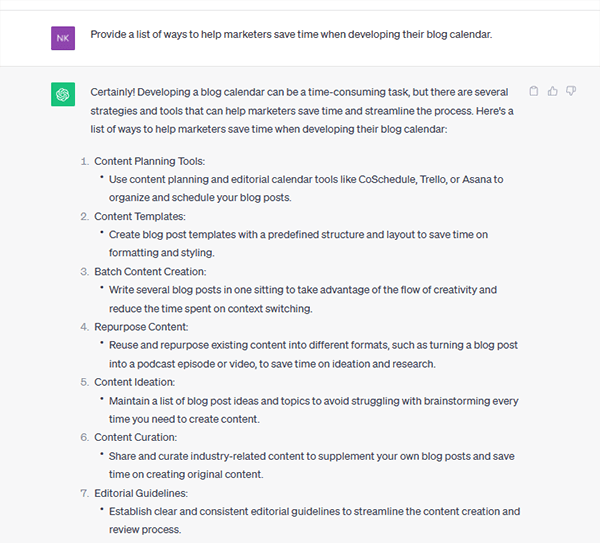We regularly hear from our partners that (while they understand the importance of consistently publishing relevant, SEO-friendly blog content) their team struggles to find the time. Fortunately, with a well-planned blog calendar—and a few of our trusty tips—you can save precious time and execute a more efficient and effective blogging strategy.
Keep reading for some time-saving hacks for planning and developing a blog content calendar that’s chock-full of great article ideas that will make an impact on your business in 2024 and beyond.
Why do I need a blog calendar?
Ever been in the car with a friend who “knows a shortcut” that ultimately adds way more time to your trip than if they’d just followed the GPS? There’s nothing wrong with going off the beaten path in life occasionally, but it’s not so great when you’re short on time.
For marketers, not having a detailed plan for article content can send you down a lot of dead-end roads. By spending a little time upfront to build out a blog calendar for the year, you can take a more strategic approach and use your valuable time and resources more efficiently.
A blog calendar (also called an editorial calendar or website content calendar) lists potential topic ideas and production timelines for blog content as it fits into your marketing plan. This is a living, breathing document you can use to flesh out new ideas, track progress on blogs, add relevant links, identify content gaps, and more.
Here are a few things you may consider including when you add blog topics to your calendar:
- The topic/theme of the article
- Its purpose/goal(s)/success metrics
- The author (and/or who is assigned to write it)
- The audience persona(s)
- Target keyword(s)
- Deadlines (e.g., first draft due date, publish date, etc.)
- URL or where it will live on your website
- How its content will be used in the marketing/sales journey
There’s no exact science to creating the perfect blog calendar. What matters is that it’s easy to use and provides all the guidance you and your team need to plan and execute a strategic content plan. It should also be flexible, so as things change in your business or with your goals, you can make adjustments as needed.
If you need a little inspiration, take a look at the following examples and find the format that works best for you.
Blog calendar examples
Your blog calendar could be a spreadsheet, a project management board (like this example from Trello), or even a standard calendar format. Just make sure the format you choose provides all the functionality you may want, like the ability to collaborate with team members, add links or attach documents, make comments, etc.


You can find many free content calendar templates online that can be copied and customized to fit your needs. (We used Hubspot’s editorial calendar template to create the Google Sheet shown above.)
Whether you use an existing template or create something from scratch, find the format that works best for you and makes updating and tracking blog activity a breeze. The easier it is to use, the more likely you and your team will be to stick with it.
Once you have the right format for your blog calendar, you can start building it out with topics to cover throughout the year. The following hacks can help you save time when generating ideas, planning your topics, and writing your blog posts.
Hacks for creating a blog calendar
Start with trending keywords
Keyword research isn’t just an SEO tactic; it’s a way to plan blog content that’s top of mind for the people who will (ideally) be reading it. When you generate blog topics based on trending keywords, you help your content rank better in search while also covering topics that can help move potential customers along in the buyer’s journey.
Based on the keywords or phrases people in your target audience are searching for on a particular subject, you can come up with related blog topics to add to your editorial calendar.
For example, let’s say you work for an orthodontics office. Some top searches might include:
- “types of braces” or “how long do you wear braces?”
Based on these keywords, you could generate relevant blog post ideas, such as:
- “3 Types of Braces and What Each Does to Improve Your Smile”
- “Ask an Orthodontist: How Long Do I Have to Wear My Braces?”
Tools such as Moz Keyword Explorer, Google Keyword Planner, SEMrush, and KWFinder can help you with keyword planning. You can create multiple blog topic ideas from clusters of related keywords or phrases and crosslink each piece of content to other relevant posts. (Just beware of keyword cannibalization and avoid using the same exact keyword for multiple blogs, which can hurt your SEO.)
Brainstorm topics with AI
According to a Gartner survey, 75% of CMOs are under increased pressure to “do more with less” to deliver profitable growth. To make the impossible possible, many marketers are turning to AI writing tools to work more efficiently and overcome time or budget constraints.
AI can help you generate ideas in an instant as you’re building out your blog calendar. You can provide as much or as little information as you’d like to get the ball rolling. You don’t have to use everything AI provides (it misses the mark quite often), but it can help spur new ideas.
Here’s an example of how I used ChatGPT (GPT-3.5) to come up with some ideas for this very blog:

Keep in mind that while AI tools like ChatGPT are helpful assistants, they’re not a replacement for human ingenuity (at least not yet). In marketing especially, we need thoughtful, creative humans to write high-quality content that resonates and inspires.
Use a cluster strategy and write blog posts in batches
Using a pillar/cluster content strategy, you can capture the core ideas or main topics that are most relevant to your business with pillar pages, then build out several sub-topics that support them (topic clusters).
For example, an orthopedic practice may have pillar pages for different areas of the body (e.g., back, knees, shoulders), with sub-topics for each (e.g., back pain, knee replacement, shoulder dislocation, etc.) that they use to create content clusters.
By clustering your blog topics, you can ensure you’re sufficiently covering each core idea and aligning your content to the wider marketing strategy. When people visit your clustered blog content, they’ll find relevant information on the topic they were searching for and easily navigate from one piece of content to another.
From a time-saving perspective, this strategy makes it easier to generate several topic ideas at once and cover many different angles of a topic. This can also save a ton of time for whoever is researching and writing the articles, as you can write several pieces at the same time or back-to-back (which will also ensure the pieces are cohesive but not repetitive).
Remember, you don’t have to publish each article as soon as it’s written. You can use your blog calendar to plan out the best days to put out specific pieces and adjust your due dates accordingly.
Source relevant topics from customer-facing team members
Crafting the most compelling and effective website content means understanding your marketing audience. And who knows your target audiences better than the people who interact with them every day, like your sales or customer service teams?
Doing one-on-one interviews with customer-facing team members can provide some great qualitative data that’s difficult to glean from analytics alone. You can take what you learn from these conversations to inform your buyer personas and brainstorm new blog topics.
Ask your colleagues about the specific questions customers frequently ask, what they value most about your business (or what they feel is lacking), and how they typically engage with your website.
You can use what you learn to fill your blog calendar with topics that answer customers’ burning questions and educate them on the things they’re hoping to learn from you. They may even be able to tell you what matters most to customers at different times of the year so you can plan to publish certain topics when they’re most relevant.
Repurpose content from other formats
Great news, marketers: You don’t have to reinvent the wheel for every blog post. Chances are, you already have some great content that could find new legs on your blog with pretty minimal effort.
The content from your organization’s videos, webinars, ebooks, whitepapers, podcasts, social media posts, and more can be used to create compelling blog content. You may even have PDFs or handouts that have some really useful information in them and just need to be reimagined for a digital format.
As you develop your blog calendar, think through all the potential gold that can be mined from your existing content and add those potential topics to your plan. Spreading them out so you have a mix of new content and repurposed content throughout the year can save time and lighten the load when it’s time for production.
Work with an experienced marketing agency
Marketers today have a lot on their plates. Not every team has the bandwidth to regularly research, write, and publish relevant, search-engine-optimized blogs on their own, and many need to hire a marketing agency to lend a hand.
For 20 years, TBH Creative has been helping marketing and sales teams hit their goals with compelling, persona-driven content and campaigns. We can help you develop a content strategy and build out your blog calendar, and we offer blog writing services to save you even more valuable time.

